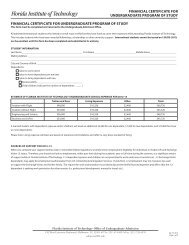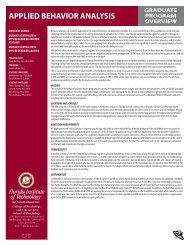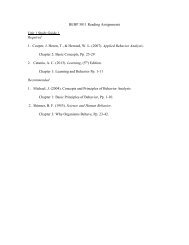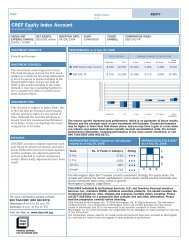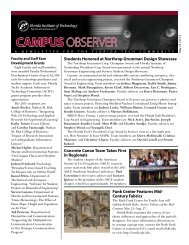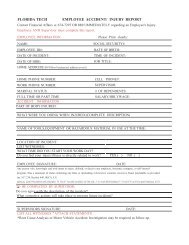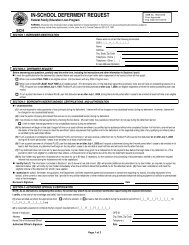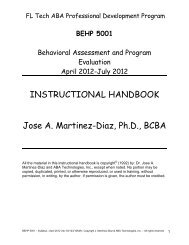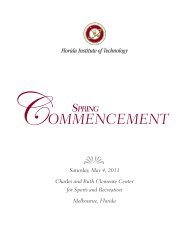2011–2012 UNIVERSITY CATALOG - Florida Institute of Technology
2011–2012 UNIVERSITY CATALOG - Florida Institute of Technology
2011–2012 UNIVERSITY CATALOG - Florida Institute of Technology
You also want an ePaper? Increase the reach of your titles
YUMPU automatically turns print PDFs into web optimized ePapers that Google loves.
States (the MEASURE array) from <strong>Florida</strong> to southern Canada.<br />
The array observations, and particle and field measurements from<br />
various satellites are used for studying the geospace environment<br />
during magnetic storms and substorms. We also have joint operational<br />
custody (with the University <strong>of</strong> <strong>Florida</strong>) <strong>of</strong> the International<br />
Center for Lightning Research and Testing (ICLRT) that is<br />
located at Camp Blanding Army National Guard Base near Starke,<br />
<strong>Florida</strong>, where airspace can be controlled for rocket-triggering.<br />
Lightning and Instrument Development Laboratory (GPL-A):<br />
A series <strong>of</strong> recent theoretical breakthroughs and experimental<br />
detector development by our team working at both this lab and the<br />
ICLRT has led to the discovery <strong>of</strong> x-ray emission from lightning<br />
and its possible central role in understanding the lightning plasma<br />
processes. Exploring the implications <strong>of</strong> this discovery is one <strong>of</strong><br />
the main goals <strong>of</strong> this research lab. At the ICLRT, lightning is<br />
artificially triggered using small rockets trailing wires; in effect<br />
telling the lightning when and where to strike. This allows detailed<br />
observation and theoretical investigations to help us better understand<br />
how terrestrial (and planetary) lightning works and how to<br />
better protect lightning-vulnerable assets.<br />
Cosmic Rays and Space Weather Laboratory (GPL-B): This<br />
lab uses a network <strong>of</strong> workstations to study the energetic particle<br />
environment in the solar system. Some <strong>of</strong> the particles are cosmic<br />
rays from the galaxy, while some are produced by the sun during<br />
solar flares. By studying these particles, we try to understand the<br />
energetic phenomena in the galaxy or on the sun that affect the<br />
radiation environment at Earth. Gaining such understanding is<br />
one <strong>of</strong> our main goals to protect astronauts working in space and<br />
the electronic components on satellites. In addition, analysis <strong>of</strong><br />
the COSPIN experiment on Ulysses and several other spacecraft<br />
datasets (Wind, SOHO, SAMPEX, ACE and RHESSI) in support<br />
<strong>of</strong> investigating the energetic particles environment with the solar<br />
system are conducted in this lab.<br />
Visualization and MHD Simulation Laboratory (GPL-C): This<br />
lab has state-<strong>of</strong>-the-art 3D visualization systems, video-processing<br />
workstations and shared memory multiprocessor systems for use in<br />
research and in the classroom. The systems use active and passive<br />
3D displays to illustrate a variety <strong>of</strong> 3-dimensional topics. Some <strong>of</strong><br />
the projects being pursued include classroom visuals such as 3D<br />
rendering <strong>of</strong> the Solar System, our Galaxy, and the Earth-Moon-<br />
Sun system. Scientific research in MHD modeling <strong>of</strong> space weather<br />
simulations is also conducted using 3D rendering as an analysis tool<br />
for studying the near-Earth space environment. Researchers are<br />
also investigating some cognitive science topics related to how the<br />
brain processes 3D imagery and how this may affect educational<br />
techniques in the physical sciences.<br />
Space Exploration Research Laboratory (GPL-D): This lab supports<br />
a research program focused on enabling sustained human<br />
space exploration and on the origin, distribution and future <strong>of</strong> life<br />
in the universe. The lab includes imaging systems, optics, calibration<br />
and test equipment, a large clean room, and other hardware<br />
used to support the development <strong>of</strong> space instrumentation. It has a<br />
high-performance computing system for modeling and simulation,<br />
and a ground control system to receive data and send commands<br />
to the International Space Station. Some <strong>of</strong> the labs activities are<br />
housed in the new Space Life Sciences Laboratory at the Kennedy<br />
Space Center, where atomic force and laser confocal fluorescence<br />
202 <strong>Florida</strong> Tech<br />
microscopes optimized for bioimaging, small-animal research<br />
hardware, and other equipment supports research into the hazards<br />
associated with long-term human exposure to the space environment,<br />
such as radiation damage, loss <strong>of</strong> bone mass, muscle atrophy<br />
and cardiovascular de-conditioning.<br />
Teaching and Research Assistantships<br />
The department <strong>of</strong>fers a number <strong>of</strong> teaching and research assistantships<br />
each year. Teaching assistants participate in laboratory<br />
instruction and/or assisting faculty in the preparation <strong>of</strong> teaching<br />
materials and grading. Research assistants work on research projects<br />
that are <strong>of</strong>ten related to their own master’s thesis or doctoral<br />
dissertation investigations. Both types <strong>of</strong> assistantships are awarded<br />
on a competitive basis, and provide graduate course fee remission<br />
and a stipend for living expenses. To increase the probability <strong>of</strong><br />
receiving an assistantship, applicants are advised to apply as early<br />
as possible in the academic year prior to requested admission.<br />
DEPARTMENT OF SCIENCE AND MATHEMATICS<br />
EDUCATION<br />
David E. Cook, Ph.D., Head<br />
Degree Programs<br />
Computer Education, M.S.<br />
Concentration in:<br />
Instructional <strong>Technology</strong><br />
Elementary Science Education, M.Ed.<br />
Environmental Education, M.S.<br />
Mathematics Education, B.S., M.S., Ed.S., Ph.D.<br />
Middle Grades Mathematics and Science, B.S.<br />
Science Education<br />
Biology, B.S.<br />
Chemistry, B.S.<br />
Earth and Space Sciences, B.S.<br />
General Science, B.S.<br />
Physics, B.S.<br />
Science Education, M.S.<br />
Informal Science Education, M.S.<br />
Science Education, Ed.S., Ph.D.<br />
Teaching, M.A.T.<br />
Graduate Certificate—Teaching<br />
Undergraduate Minor Program<br />
Education<br />
Pr<strong>of</strong>essor<br />
David E. Cook, Ph.D., informal science education, computers in education,<br />
chemistry education, education policy.<br />
Associate Pr<strong>of</strong>essors<br />
Michael A. Gallo, Ph.D., statistics, research design, educational theory,<br />
computer technology and networking.<br />
Cecilia A. Knoll, Ph.D., calculus mastery, differential equations, integrating<br />
technology into the curriculum.<br />
Thomas J. Marcinkowski, Ph.D., environmental education, curriculum and<br />
instruction, research and evaluation design.<br />
Instructor and Director, Teacher Education<br />
Debra S. Blenis, M.S.<br />
Pr<strong>of</strong>essors Emeriti<br />
Richard E. Enstice, Ph.D.; Robert H. Fronk, Ph.D.;Robert F. Richmond, Ed.S.




